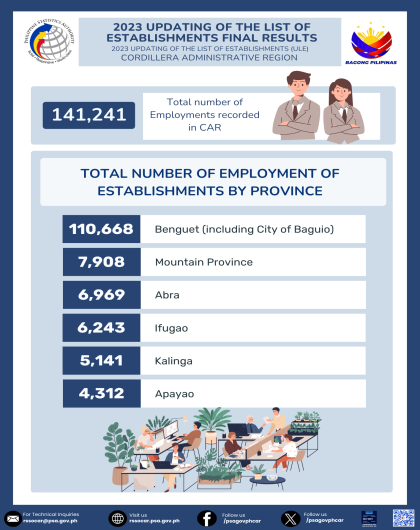The List of Establishments (LE) is a database of all establishments in the Philippines undertaken by the Philippine Statistics Authority which aims to primarily provide a sampling frame for the census and survey of establishments in the region. It involves capturing new and old establishments and listing their characteristics.
As of 2014, records in the LE show that there were 946,988 establishments in the country, employing about 7.8 million persons in 17 geographical regions.
Of the total establishments in the country, 18,267 of these or 1.9% were found in the Cordillera Administrative Region (CAR). These establishments employed about 102,469 persons.
Among the CAR provinces, Benguet including Baguio City registered 12,941 establishment which had the highest number accounting to 70.8% of the total establishments in the region. These establishments employed 84,582 persons contributing to 82.5% of the total employment in CAR.
Kalinga placed second with 1,511 establishments or 8.3% of the total number of establishments in CAR. These establishments employed about 5,851 persons.
Mountain Province had 1,456 establishments comprising 8.0% of the total establishments in the region and employing 3,558 persons. Abra had 1,161 establishments (6.4%) with 4,614 employees. Ifugao had 879 establishments (4.8%) with 2,663 employees. Apayao had the least number of establishments with 319 number of establishments (1.17%) employing 1,201 persons.
Classification of Establishments in CAR
- The 2009 Philippine Standard Industrial Classification (PSIC) defines and classifies establishments as to industry section. The LE covers economic activities under the 18 industry sections (Figure 1) as defined in the (PSIC), including establishments based on their Economic Organization (EO), Legal Organization (LO), and establishment size.
Industrial Classification
- Under the industrial classification, nearly half of the total establishments in the region (44.9%) were primarily engaged in Wholesale and Retail Trade, and Repair of Motor Vehicles and Motorcycles (Sector G), followed by Accommodating and Food Service Activities (Sector I ) at 17.8%, and Manufacturing (Sector C) at 11.3%
- On the other hand, Water Supply; Sewerage, Waste management and Remediation Activities (Sector E), Mining and Quarrying (Sector B), and Transportation and Storage (Sector H) had the smallest number with 11, 17, and 27 establishments respectively.
Economic Organization
- As per economic organization, Single Establishment (EO=1) took the lead with 16,233 establishments that accounts to 88.9% of the regional total. This is followed by Branch only (EO=2) at 8.1% (1,482 establishments), while Establishment and Main Office (EO=3) were at 2.4% (445 establishments). Meanwhile, Main Office only (EO=4), and Ancillary Unit (EO=5) had the least number at 0.3% or 57 and 50 establishments respectively.
Legal Organization
- As to legal organization, Single Proprietorship posted the largest number with 16,227 establishments which is 88.8% of the regional total, followed by Stock Corporation at 6.4% (1,178 establishments). Cooperative were at 1.8% (320 establishments), Nonstock/ Non-profit Corporation at 1.6% (301 establishments), Government Corporation and Others had the least number at 0.2%.
Establishment Size
- The size of an establishment is determined by its total employment. Out of the 18,267 establishments in the region, 16,991 of these or 93.0% were categorized as Micro. These establishments employed about 43,255 persons or 42.2% of the total employment of the region which was estimated at 102,469 employees.
- Establishments operating as Small enterprises consists of 1,196 with 24,899 persons employed, representing 6.5% of the total employment of the region. On the other hand, 42 establishments belong to the Large scale operation employing about 29,048 persons or 28.3% of the total employment in the region.
Technical Notes
Ancillary is a unit that operates primarily or exclusively for a related establishment or group of related establishments or its parent establishment and provides services that support those establishments.
Legal Organization (LO) is the legal form of the economic entity that owns the establishment.
Single Proprietorship refers to a business establishment organized, owned and managed by one person, who alone assumes the risk of the business enterprise.
Partnership refers to an association of two or more individuals for the conduct of a business enterprise based upon an agreement or contract.
Government Corporation refers to a corporation organized for private aim, benefit or purpose with the government as the majority stockholder, regardless of whether they are stock or non-stock corporations.
Corporation refers to an artificial being created by operation of law, having the right of succession, and the powers, attributes and properties expressly authorized by law.
Stock Corporation refers to an ordinary business corporation organized by private persons, created and for the purpose of making a profit which may be distributed to stockholders on the basis of their invested capital.
Non-stock, Non-profit Corporation refers to a business corporation which does not issue stock to its members and are created not to profit but for the public’s good and welfare.
Cooperativerefers to an organization composed primarily of small producers and/or consumers who voluntarily join together to form a business enterprise.
Establishment is an economic unit that produces and/or sells goods or services, and operates from a single physical location.
Economic Organization is the organizational structure or role of the establishment in the organization
Single Establishment is an establishment which has neither branch nor main office.
Branch only is an establishment which has a separate main office located elsewhere.
Establishment and Main office is one which both located in the same address and with branch/es elsewhere.
Main office only is a unit which controls, supervises and directs one or more establishments of an enterprise.


